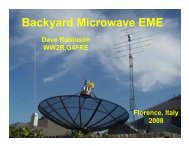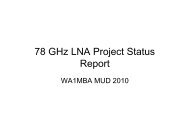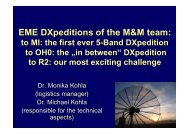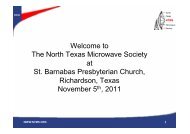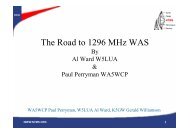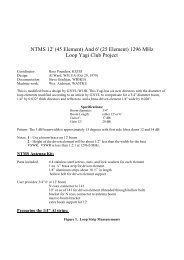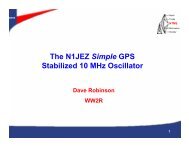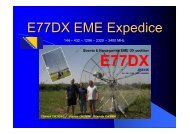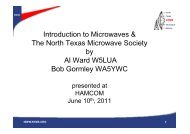Create successful ePaper yourself
Turn your PDF publications into a flip-book with our unique Google optimized e-Paper software.
W5HN<br />
North<br />
Texas<br />
<strong>NTMS</strong><br />
14 th International EME Conference<br />
Dallas-Ft.Worth, Texas<br />
Microwave<br />
Society<br />
Homebrew <strong>TWT</strong> <strong>Power</strong> <strong>Supplies</strong><br />
Gerald Williamson <strong>K5GW</strong><br />
Al Ward W5LUA<br />
August 13, 2010<br />
WWW.<strong>NTMS</strong>.ORG 1
W5HN<br />
Non-Suppressed Collector <strong>TWT</strong><br />
B1<br />
Fil V Adj<br />
North<br />
Texas<br />
<strong>NTMS</strong><br />
Microwave<br />
Society<br />
FIL/AIR<br />
ON<br />
HV<br />
ON<br />
Cathode<br />
-<br />
PSU +<br />
R1<br />
HV RY<br />
Cathode<br />
Collector<br />
Input<br />
Helix I<br />
Trip<br />
<strong>TWT</strong><br />
Output<br />
Most of the cathode current must flow to the collector<br />
Must minimize current that flows to the helix<br />
Proper focusing of the beam minimizes helix current and maximizes power output.<br />
Filament power supply at cathode potential w.r.t. ground.<br />
Must use HV relay in secondary to start tube in less than 100msec – can not wait for<br />
cathode power supply to charge any capacitance otherwise tube will be out of focus<br />
and current will intersect helix – could destroy tube if helix trip-out circuit not used.<br />
R1 used to limit cathode current in case of internal arcing.<br />
WWW.<strong>NTMS</strong>.ORG 2
W5HN<br />
Using the Anode to control <strong>TWT</strong><br />
B1<br />
Fil V Adj<br />
North<br />
Texas<br />
<strong>NTMS</strong><br />
Microwave<br />
Society<br />
FIL/AIR<br />
ON<br />
HV<br />
ON<br />
Cathode<br />
-<br />
PSU +<br />
R1<br />
2M ohm<br />
Cathode<br />
Anode/Grid<br />
Input<br />
Helix I<br />
Trip<br />
HV RY<br />
<strong>TWT</strong><br />
Collector<br />
Output<br />
Some <strong>TWT</strong>s have a grid or an anode to either modulate the cathode current or to<br />
be used as a means to turn <strong>TWT</strong> on and off quickly.<br />
When the anode is at cathode potential, the <strong>TWT</strong> is turned off.<br />
When the anode is at helix or ground potential, the <strong>TWT</strong> is turned on.<br />
2M ohm resistor keeps anode at cathode potential until HV relay switches anode to<br />
helix potential.<br />
WWW.<strong>NTMS</strong>.ORG 3
W5HN<br />
Suppressed Collector Tube - Operating<br />
the Collector below Helix Potential<br />
North<br />
Texas<br />
<strong>NTMS</strong><br />
Microwave<br />
Society<br />
B1<br />
Fil V Adj<br />
FIL/AIR<br />
ON<br />
HV<br />
ON<br />
Cathode<br />
-<br />
PSU +<br />
Helix I<br />
Trip<br />
4.4kV<br />
2M ohm<br />
Cathode<br />
Anode/Grid<br />
HV RY<br />
<strong>TWT</strong><br />
Input<br />
4.4kV<br />
2.7kV<br />
Collector<br />
Output<br />
R1<br />
1.7kV<br />
Typically Collector can be operated at about 60% of Helix Potential<br />
Simplest but not best approach is to dissipate the extra power in R1<br />
40% of the power is then dissipated in series dropping resistor R1<br />
WWW.<strong>NTMS</strong>.ORG 4
W5HN<br />
Using dual supplies for Helix and<br />
Collector<br />
Fil V Adj<br />
B1<br />
North<br />
Texas<br />
<strong>NTMS</strong><br />
Microwave<br />
Society<br />
FIL/AIR<br />
ON<br />
HV<br />
ON<br />
Helix<br />
-<br />
PSU +<br />
4.4kV<br />
2M ohm<br />
Cathode<br />
Anode/Grid<br />
Input<br />
Helix I<br />
Trip<br />
HV RY<br />
<strong>TWT</strong><br />
Collector<br />
PSU<br />
-<br />
+<br />
2.7kV<br />
R1<br />
Collector<br />
Output<br />
Using separate supplies minimizes high cathode to collector potential when no current<br />
is flowing – could damage <strong>TWT</strong><br />
Helix power supply supplies only a few mA of current for the helix<br />
Collector power supply supplies high current for the collector.<br />
R1 still nice to have to minimize the “big bang” effect of internal <strong>TWT</strong> arcing – only<br />
need maybe 500 ohms for a voltage drop of 150V at 300mA of collector current<br />
WWW.<strong>NTMS</strong>.ORG 5
W5HN<br />
The <strong>K5GW</strong> Approach - Using<br />
<strong>Power</strong> <strong>Supplies</strong> in Series<br />
North<br />
Texas<br />
<strong>NTMS</strong><br />
Microwave<br />
Society<br />
B1<br />
Fil V Adj<br />
FIL/AIR<br />
ON<br />
HV<br />
ON<br />
Helix<br />
Adj<br />
Collector<br />
-<br />
PSU<br />
+<br />
Helix<br />
-<br />
PSU +<br />
Ccol<br />
R1<br />
Chelix<br />
HV RY<br />
2.7kV<br />
1.7kV<br />
Cathode<br />
Collector<br />
<strong>TWT</strong><br />
Input<br />
Output<br />
Helix I<br />
Trip<br />
Enclosure out at Feed<br />
A lot of high power tubes either do not have an anode or it is internal connected to the<br />
helix/ground – requiring the use of a HV relay in the cathode to turn the <strong>TWT</strong> on.<br />
Collector supplies 2.7kV<br />
Helix supply is “piggy backed” or in series with the collector supply upping the collector by<br />
another 1.7kV and then having its return to the helix through the trip circuit to ground.<br />
WWW.<strong>NTMS</strong>.ORG 6
W5HN<br />
120VAC<br />
Schematic Diagram <strong>TWT</strong> HV PS<br />
20A<br />
.01ohm<br />
see text<br />
Ry1<br />
Rstby<br />
Ry2a<br />
Rstby<br />
Ry2b<br />
T4<br />
T1<br />
T2<br />
T3<br />
8 x 470uF/450V & 270K/3W<br />
IuF<br />
50uF/10V<br />
Rcal<br />
Ic Mon<br />
IcTrip<br />
M<br />
4x1N5408 Diodes<br />
500 ohm/200W<br />
M<br />
HV RY<br />
Ry3<br />
12 x 470uF/450V & 270K/3W<br />
Rcal<br />
100 ohm<br />
Cathode<br />
Collector<br />
IhTrip<br />
North<br />
Texas<br />
<strong>NTMS</strong><br />
Microwave<br />
T1 is a 2500vrms transformer from an AL1200HF amplifier to supply collector current.<br />
T2 is a used microwave oven transformer used to boost the collector voltage high enough for the<br />
helix – A variac at T4 is used in the primary to set the helix voltage.<br />
Rstby in series with T1 and T2 are used to lower the voltages during standby.<br />
T3 samples current drawn from ac lines which is proportional to collector current – Rcal used to<br />
calibrate collector current meter.<br />
100Ωresistor used to sample helix current – 1N5408 diodes protect meter circuit in event of<br />
internal <strong>TWT</strong> arc over.<br />
Society<br />
WWW.<strong>NTMS</strong>.ORG 7
W5HN<br />
AC & TR Control & Trip Circuits<br />
North<br />
Texas<br />
<strong>NTMS</strong><br />
Microwave<br />
Society<br />
120VAC Input<br />
Neutral<br />
120VAC to<br />
<strong>TWT</strong> Air/Fil<br />
3A<br />
Air/Fil On<br />
SW1<br />
T5<br />
1000uf/50V<br />
Ry4<br />
n/c<br />
Trip<br />
Ind<br />
510<br />
Ry5<br />
Trip<br />
Ind<br />
HV On<br />
SW2a<br />
510<br />
Ry1<br />
Ih Trip<br />
Threshold<br />
Trip Adj<br />
150 ohm<br />
TIP120<br />
1K<br />
1K<br />
1K<br />
n/o<br />
n/c<br />
Reset Trip<br />
Ic Trip<br />
Threshold<br />
Trip Adj<br />
1K<br />
1K<br />
150 ohm n/o Reset Trip<br />
TIP120<br />
1K<br />
n/c<br />
HV On<br />
SW2b Ry2 Ry3<br />
XMIT/PTT<br />
28VDC<br />
Helix and Collector current trip circuits provide <strong>TWT</strong> protection and indication of fault.<br />
Must be manually reset with push button switches to regain <strong>TWT</strong> operation.<br />
WWW.<strong>NTMS</strong>.ORG 8
W5HN<br />
Ek<br />
HV Monitor<br />
Ec<br />
North<br />
Texas<br />
<strong>NTMS</strong><br />
Microwave<br />
Society<br />
16 x 250K<br />
Cal<br />
Cal<br />
10K<br />
1<br />
2<br />
3<br />
M<br />
1<br />
2<br />
3<br />
1 - Ek<br />
2 - Eh(boost)<br />
3 - Ec (Ek-Eh)<br />
16 x 250K<br />
Cal<br />
10K<br />
Clarification from the paper in the<br />
proceedings – Position number 1 does<br />
measure the Ek which is the cathode<br />
to helix voltage, position number 2<br />
measures Eh which is actually the<br />
helix boost voltage, and position<br />
number 3 measures the difference Ec<br />
which is the collector voltage.<br />
Approximately 1000:1 resistive voltage dividers are used to safely sample the<br />
voltages at the cathode and collector w.r.t ground.<br />
WWW.<strong>NTMS</strong>.ORG 9
W5HN<br />
Completed <strong>TWT</strong> <strong>Power</strong> Supply<br />
North<br />
Texas<br />
<strong>NTMS</strong><br />
Microwave<br />
Society<br />
Outlet fan<br />
Inlet fan and filter<br />
WWW.<strong>NTMS</strong>.ORG 10
W5HN<br />
Internal Views of the Completed<br />
<strong>TWT</strong> <strong>Power</strong> Supply<br />
North<br />
Texas<br />
<strong>NTMS</strong><br />
Microwave<br />
Society<br />
WWW.<strong>NTMS</strong>.ORG 11
W5HN<br />
<strong>TWT</strong> Cooling Assembly<br />
North<br />
Texas<br />
<strong>NTMS</strong><br />
Microwave<br />
Society<br />
Heat Sink<br />
Blower – Dayton 1TDR6 rated for 110 CFM<br />
WWW.<strong>NTMS</strong>.ORG 12
W5HN<br />
Internal Views of the Completed<br />
<strong>TWT</strong> Assembly<br />
North<br />
Texas<br />
<strong>NTMS</strong><br />
Microwave<br />
Society<br />
Air filter from a shop vacuum<br />
WWW.<strong>NTMS</strong>.ORG 13
W5HN<br />
Various High <strong>Power</strong> <strong>TWT</strong>s<br />
North<br />
Texas<br />
<strong>NTMS</strong><br />
Microwave<br />
Society<br />
Occasional gift from<br />
TSA when carrying<br />
one of these in your<br />
checked luggage<br />
WWW.<strong>NTMS</strong>.ORG 14
W5HN<br />
Summary<br />
North<br />
Texas<br />
<strong>NTMS</strong><br />
Microwave<br />
Society<br />
• The techniques described here have been<br />
used successfully with high power 200<br />
watt plus tubes at <strong>K5GW</strong> and the echoes<br />
are very nice!<br />
• Any Questions<br />
WWW.<strong>NTMS</strong>.ORG 15



